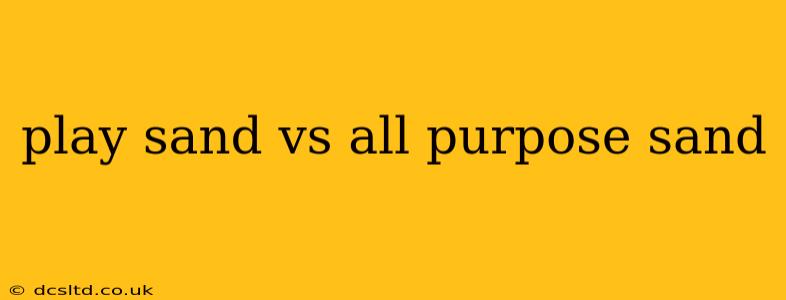Choosing the right sand for your project, whether it's a magnificent sandcastle on the beach or a sturdy concrete foundation, requires understanding the key differences between various types. This article will delve into the specifics of play sand versus all-purpose sand, helping you make an informed decision for your needs.
What is Play Sand?
Play sand is specifically manufactured for children's play areas and sandboxes. Its primary distinction lies in its fineness and lack of sharp edges. This is crucial for safety; smooth, fine grains minimize the risk of cuts and abrasions to delicate skin. It's also typically washed to remove impurities and potentially harmful substances. Because of its processing, play sand is generally more expensive than other types of sand.
Is Play Sand Safe for Children?
Yes, play sand is designed with child safety in mind. However, it's essential to remember that even play sand can contain small stones or other debris, so supervision is always recommended during playtime. Regularly checking and cleaning the sandbox is also important to maintain hygiene and safety.
What is All-Purpose Sand?
All-purpose sand, as its name suggests, has a broader range of applications. It's a more coarse and less refined type of sand, often containing a mix of grain sizes and potentially some small stones or shells. This makes it suitable for construction projects like mortar mixes, landscaping, and even some types of filtration systems. Its coarser texture and potentially higher impurity level make it less ideal for direct contact with children's skin.
Can All-Purpose Sand be Used for Play?
While technically possible, it's strongly discouraged to use all-purpose sand in a sandbox or for children's play. The coarser texture and potential for sharp particles present a higher risk of injury. Furthermore, impurities might not be suitable for prolonged skin contact.
Key Differences: Play Sand vs. All-Purpose Sand
| Feature | Play Sand | All-Purpose Sand |
|---|---|---|
| Grain Size | Fine, uniform | Variable, coarser |
| Sharpness | Smooth, rounded edges | May contain sharp particles |
| Purity | Washed, cleaner | May contain impurities, shells, or stones |
| Cost | More expensive | Less expensive |
| Applications | Sandboxes, children's play areas | Construction, landscaping, filtration |
| Safety | Designed for children's skin contact | Not suitable for children's skin contact |
What are the different types of sand used in construction?
Construction projects often utilize various sand types depending on the application. For example, concrete typically uses coarser sands for strength, while plaster might employ finer sands for a smoother finish. The specific sand type will be determined by the project requirements and specifications. This is a complex topic and beyond the scope of this article focusing on play sand versus all-purpose sand, but a simple internet search can lead you to more in-depth articles on construction sands.
How do I choose the right sand for my project?
The selection of the correct sand heavily relies on the intended use. For children’s play areas, play sand is the absolute priority due to its safety features. For other applications, like landscaping or construction, all-purpose sand or more specialized construction sands are appropriate. Always check the product label for specifics on its suitability and intended use.
By understanding the key differences between play sand and all-purpose sand, you can make an informed decision for your specific needs, prioritizing safety and functionality. Remember, when it comes to children's play, play sand is the safer and more appropriate option.
